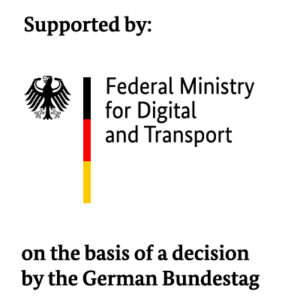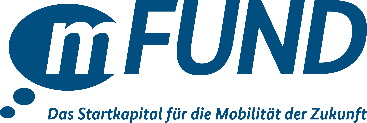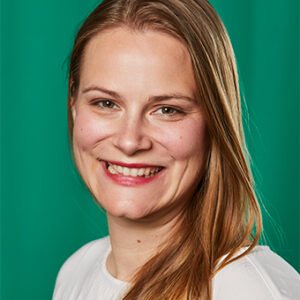Fine Dust Measurement to Reduce Exposure When Cycling or Walking
App provides data on individual fine dust pollution
Research focus: Sustainable Engineering and Energy
Commuting on foot or by bike can be essential to a healthy, active lifestyle. But how healthy is the air we breathe when we do so? The project “Gesundheitliche Optimierung der Fußgänger- und Fahrrad-Infrastruktur” (Health Optimization of Pedestrian and Bicycle Infrastructure) provides data on individual fine dust exposure in an app for the first time. The results can also help city planners to implement health-oriented infrastructure measures.
According to the WHO, fine dust is the fourth most common cause of death worldwide and plays a significant role in the development of respiratory diseases, cancer, and cardiovascular disease. Until now, there has been no reliable, individually scaled database to assess the health risk for active road users realistically – this is precisely where IDEA System GmbH, the FZI Research Center for Information Technology, and the Karlsruhe Institute of Technology (KIT) come in. Their project, Gesundheitliche Optimierung der Fußgänger- und Fahrrad-Infrastruktur, is funded by the German Federal Ministry for Digital and Transport with a total of €134,135.50 as part of the mFUND innovation initiative.
“Pedestrians and cyclists are a risk group because they are directly exposed to fine dust. They can actively reduce their risk if they know which route is congested. Conversely, the traffic infrastructure can be optimized based on the citizens’ measurement results,” says Prof. Dr. Hans Richard Doerfel, founder and managing director of IDEA System GmbH. To develop an app that allows pedestrians and cyclists to measure their fine dust exposure on their daily routes in urban areas and derive their health risk, he entered into a cooperation with the FZI Research Center for Information Technology and the Institute of Sports and Sports Science at KIT.
The result is a prototype for a fine dust dosimeter app. Based on the individual breathing volume and the location- and time-dependent concentration of fine dust in the air, it measures the fine dust exposure of users per distance traveled: The respiratory volume, speed, distance, gradient, fine dust pollution, and the probable amount of fine dust inhaled in particle sizes < 2.5 µm and < 10 µm are displayed to users at the end of their trip.
“Until now, we knew where the air was polluted, but not to what extent people inhaled it. The biggest challenge was to measure individual exposure realistically and to combine technology, medicine, and traffic planning to do so,” says Christoph Becker, researcher and project manager at the FZI. The prototype app now retrieves the location every 10 seconds during recording, stores the measured speed of the user, and retrieves the local fine dust concentration. The app obtains the data on fine dust pollution from Google. The app divides the route into sections with approximately the same speed and calculates the parameters required for the inhalation function. From these parameters, the app determines the average respiratory volume using the empirical inhalation function and, together with the particulate matter pollution, finally calculates the amount of particulate matter inhaled for each section.
The average respiratory volume when walking and riding a Dutch bike, a mountain bike, and a racing bike was determined by the KIT Sports Institute in stress tests. The researchers considered body size, weight, speed, and terrain profile. “While we only inhale 6 to 8 liters of air per minute at rest, this value quickly increases to 40 to 50 liters when walking or cycling, ultimately increasing fine dust intake. In addition, the volume of air inhaled is highly dependent on individual factors. App users can therefore enter this information to enable a precise estimate,” says Dr. Stefan Altmann from KIT.
With the fine dust dosimeter app, the project partners provide a practical tool showing pedestrians and cyclists their individual exposure and helping urban planners implement targeted health-oriented infrastructure measures. Further development of the app is already in the planning stage, including the integration of fine dust-sensitive routing functions and expansion to include other pollutants such as nitrogen oxides. Wearables for more precise measurement of breathing volume are also conceivable.
The mPACT-PulseTalk titled “Fine Dust and Mobility” will look at air pollution control on May 14, 2025, at 1:30 p.m. The focus will be on how data-driven innovations, Artificial Intelligence, and innovative sensor technology can be used to launch new approaches for greater efficiency in transportation. For more information and registration, please visit: https://daten.plus/mpact-pulse-talk-17
About the FZI
The FZI Research Center for Information Technology, with headquarters in Karlsruhe and a branch office in Berlin, is a non-profit institution for information technology application research and technology transfer. It delivers the latest scientific findings in information technology to companies and public institutions and qualifies individuals for academic and business careers or the leap into self-employment. Supervised by professors from various faculties, the research groups at the FZI develop interdisciplinary concepts, software, hardware and system solutions for their clients and implement the solutions found as prototypes. The FZI House of Living Labs provides a unique research environment for application research. The FZI is an innovation partner of the Karlsruhe Institute of Technology (KIT) and strategic partner of the German Informatics Society (GI).
About the Karlsruhe Institute of Technology (KIT)
As “The Research University in the Helmholtz Association,” KIT creates and transfers knowledge for society and the environment. Its goal is to significantly contribute to global energy, mobility, and information challenges. To this end, around 10,000 employees work together on a broad disciplinary basis in natural sciences, engineering, economics, and the humanities and social sciences. Through research-oriented university studies, KIT prepares its 22,800 students for responsible tasks in society, business, and science. Innovation at KIT bridges the gap between knowledge and application for the benefit of society, economic prosperity, and the preservation of our natural resources. KIT is one of Germany’s universities of excellence.
About the mFUND funding program of the BMDV
As part of the mFUND innovation initiative, the BMDV has been funding data-based research and development projects for the digital and connected mobility of the future since 2016. The project funding is supplemented by active professional networking between stakeholders from politics, business, administration, and research, as well as by providing open data on the Mobilithek platform. Further information is available at www.mFUND.de.



Press contact
Frieda-Sophie Lammert
Division Manager Communications
- +49 721 9654-928
- presse@fzi.de
- Headquarters Karlsruhe
Download press release (pdf):
Media download:
Please click to download.
Further downloads & links:
